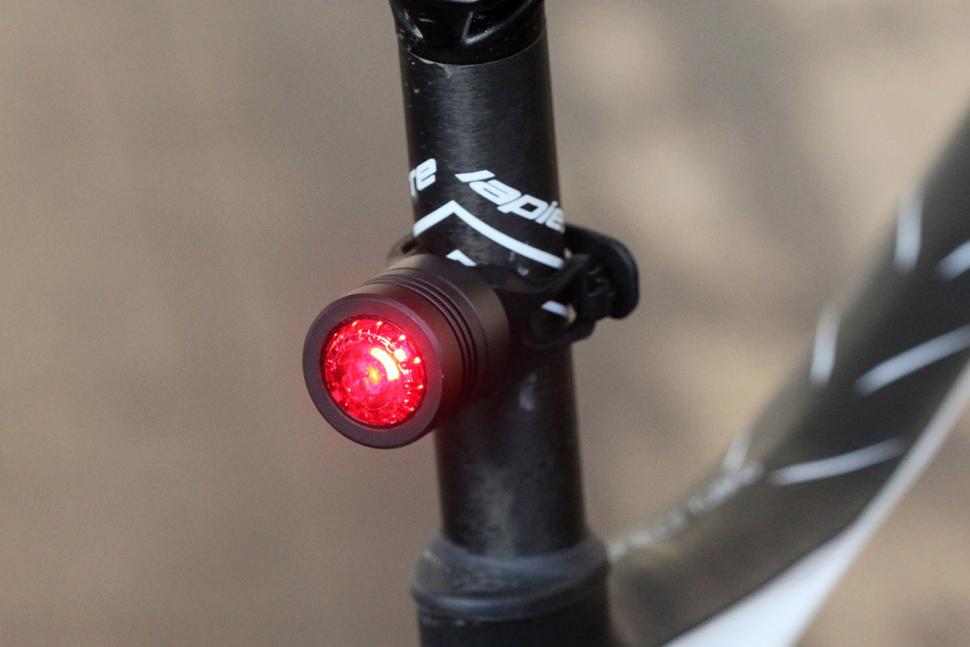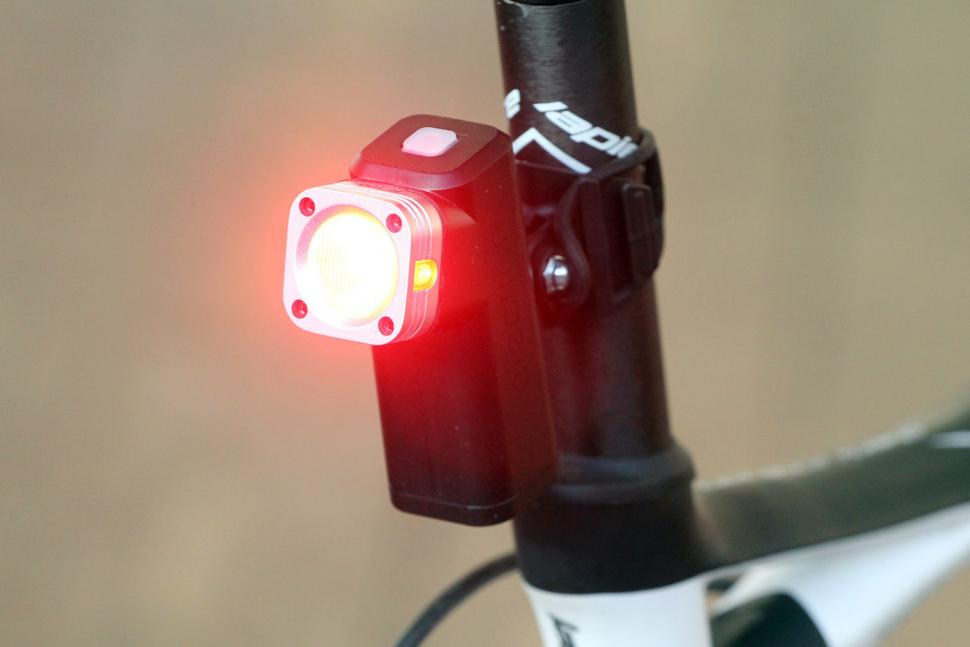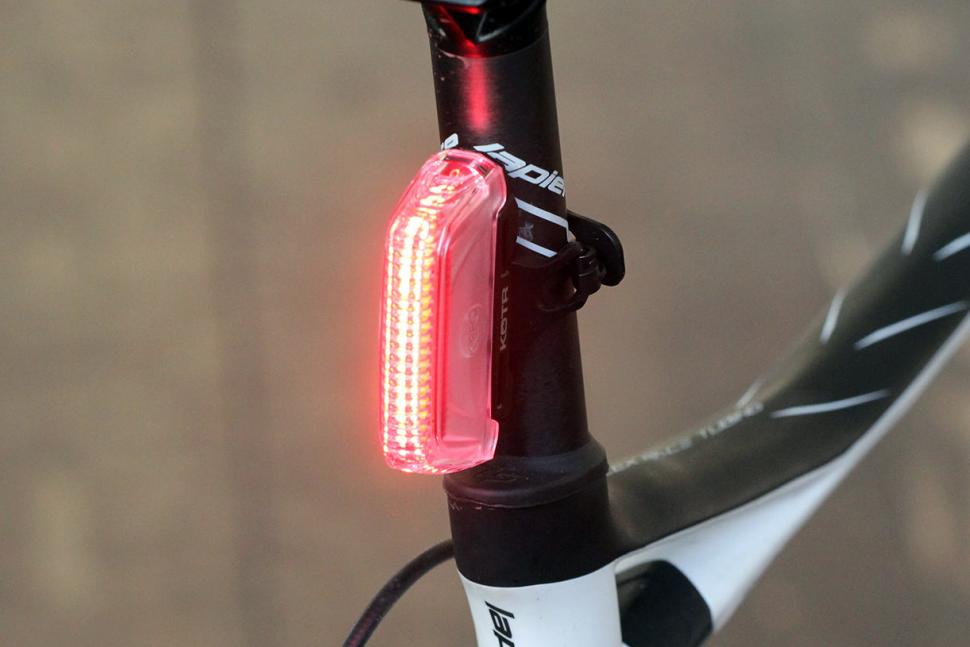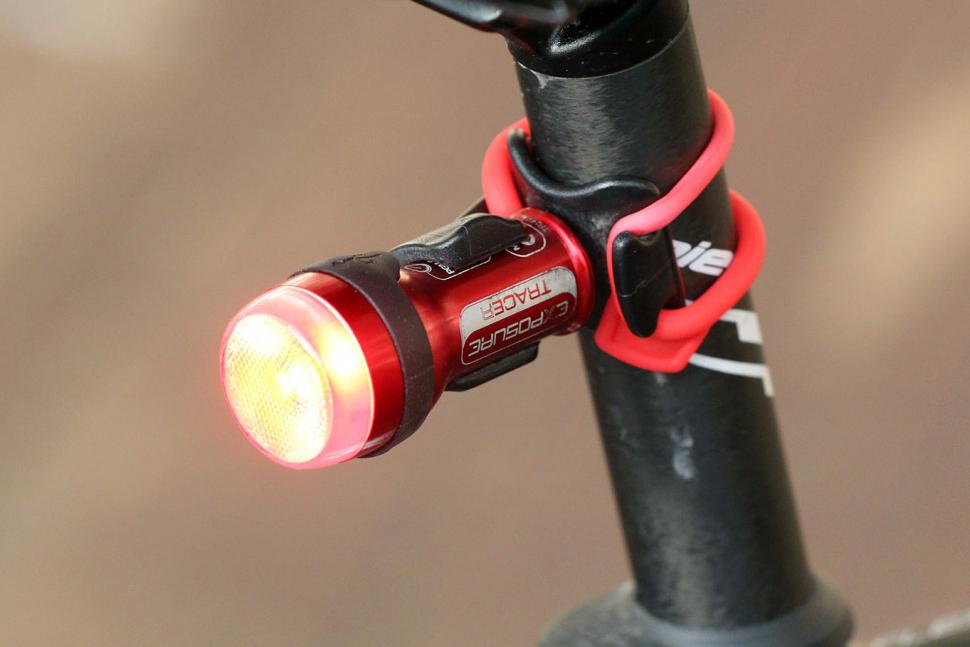If you're after a front light, we've got you nicely covered. But what about a red one for the rear of your bike? Don't worry, we're all over that too!
Get yourself seen
A rear light has the proverbial one job: to get you seen, unlike a front light that has to be visible enough to stop inattentive drivers mowing you down while allowing you to see where you're going. Depending on where and how you ride, your priorities regarding brightness, flashing modes and battery life will be different.
The Road Vehicle Lighting Regulations say:
Rear lamp
One is required, to show a red light, positioned centrally or offside, between 350mm and 1500mm from the ground, at or near the rear, aligned towards, and visible from, behind. If capable of emitting a steady light, it must be marked as conforming to BS3648, or BS6102/3, or an equivalent EC standard. If capable of emitting only a flashing light, it must emit at least 4 candela... the light shown by the lamp when flashing shall be displayed not less than 60 nor more than 240 equal times per minute and the intervals between each display of light shall be constant.
Given that every light we know of has a steady mode, that means you need an British Standard-approved light to comply with the law. To be fully compliant with the law your bike also needs a front light, front and rear reflectors, and amber pedal reflectors.
In practice, not many bike lights are Kitemarked. The specification for cycle lights dates back to 1986 and is written mostly with filament bulbs in mind; every single light we've been sent for the last few years is an LED. LED lights can meet the requirements but lots of them aren't specifically tested for the ageing British Standard, especially those that are sold worldwide.
Since the Road Vehicles Lighting Regulations (RVLR) was amended to allow cyclists to fit flashing LEDs, we've heard very little about cyclists being stopped for having non-compliant lights. In theory running a non-approved light could be used as an argument for contributory negligence in the case of an accident, though we've not heard of such a case being brought as yet.
Things to consider
What kind of riding will I be doing?
If you're mostly just pootling to the shops and back then something basic will probably do the job. Simple flashers that use button cells or AAA batteries are cheap and effective these days, and they last ages before the battery needs replacing.
If your commute is on busier roads, or you plan to do longer rides at night, you'll probably want something brighter. There's a wealth of USB-rechargeable and brighter AAA-powered rear lights about that will catch a driver's attention from further afield. Many riders who spend a lot of time on the road after dark fit more than one rear light to increase their chances of being seen.
Some rear lights are bright enough to be used in daylight too. There's certain types of riding – racing a time trial on a fast A-road, for example – where you'd want to be running the brightest rear light you can buy. Plenty of city riders run their rear lights in daytime hours too.
Flashing or not?
In terms of the law, it's up to you. The law requires flashing modes to be between 1Hz and 4Hz (one to four flashes per second); as you'll see from the beam comparison engine below, actual modes vary considerably and some fall well outside that. Pulsing constant modes are a grey area.
Ask a rider why they have their light flashing and they'll often argue that it makes them visible from further away. Ask another rider why they have a constant light and you'll often hear that it makes distance easier to judge for following vehicles.
There's not a lot of scientific research to hang your choice on. Most people who run two lights will have one of them flashing. One thing to bear in mind is that if you're riding in a close group – be that a club run, sportive, Audax or anything else – having a bright light flashing in your eyes at close range is pretty annoying. Many lights have low-power steady modes for group riding.
All-round visibility
Most rear lights are nice and bright if you're standing directly behind them. But in many situations – and especially for urban riding – traffic may be approaching you from other directions, so it's good for a light to have a wide angle of visibility. Again, the type of riding you do will dictate how important side visibility is to you.
Battery life
Most rear lights will cope easily with the longest ride you're likely to throw at them, though not all USB-rechargeable ones can be fully trusted to last a whole night, especially on steady beam. If you're planning some big forays into the dark unknown – or if you're just a bit crap at remembering to charge your lights – pick something that has a long run time. AAA-powered lights tend to be the pick for that.
Recommended lights
Blackburn Mars Click — £9.99
Still very hard to beat in terms of build quality, burn time, output relative to size and good old fashioned value for money, the Mars Click runs for at least 70 hours from a pair of CR2032 cells. The lens is the switch, which makes it one of the easiest lights to operate in thick gloves, and it has oodles of side visibility. A design classic.
Read our review of the Blackburn Mars Click
Find a Blackburn dealer
Cateye TL-LD600 — £13.42
A classic that's still going strong, the TL-LD600 has five decently bright LEDs and runs off a pair of AAA batteries. It excels as a round-town attention-grabber because of the mode in which the lit LED scans across the panel: think Knight Rider or Cylon Centurion.
Find a Cateye dealer
Blackburn Mars 4.0 — £19.99
With a bright, one-watt LED and a pair of amber sidelights, the Mars 4.0 pumps out plenty of light and will keep doing so for 150 hours on flashing mode, powered by a pair of AAA cells. It comes with a dedicated rack mounting bracket and a tool-less seat post mount
Read our review of the Blackburn Mars 4.0
Find a Blackburn dealer
Lucas KOTR City 25R — £24.99
Literally a great all-rounder, the KOTR 25 is visible from a full 180° and makes superb use of its 25-Lumen output.
Read our review of the Lucas KOTR City 25R
Nite Rider Sentinel — £24.99
Dr Evil would love it. As well as powerful two-watt LED, the Sentinel shows riders how much space you'd like them to leave when they pass by drawing a virtual bike lane on the road with frickin' laser beams. Shark not included.
Read our review of the Niterider Sentinel
Exposure Lights TraceR — £42.46
This super-bright and tough little USB rear light from UK illuminati Exposure pumps out plenty of light and will last for a week's medium-distance commuting (4-5 miles) between charges. It's not cheap, but it is excellent.
Read our review of the Exposure Lights TraceR & matching front Trace set
Find an Exposure lights dealer
Magicshine MJ-818— £49.94
This is the standalone version of the MJ-818 which uses a 3-watt LED for maximum visibility with nine smaller emitters to cover a wide range of angles. In this package it's paired with a 8.4V 4.4Ah battery. If you already have a Magicshine light, then you can get the light and a cable splitter for £31.94
Read our review of the Magicshine MJ-818
See.Sense Icon — £64.95
We loved the clever speed-sensing function and incredible brightness of the See.Sense 2.0 last year. So far we're similarly impressed with its successor, the Icon, which has a conventional switch to replace the confusing sequence of control motions of the original. It's extraordinarily bright and can be set up from an accompanying iPhone app, in combination with which it'll alert your nominated emergency contact if you crash.
Read our review of the original See.Sense lights
Find a See.Sense dealer
Lupine Rotlicht — £74.99
Another light with value-added smart functions, the Rotlicht acts as a brake light, brightening when you decelerate, and has a light sensor so it can adjust its output to the conditions. Clever stuff.














